Comprehensive Analysis of 103A Roller Skate Wheels
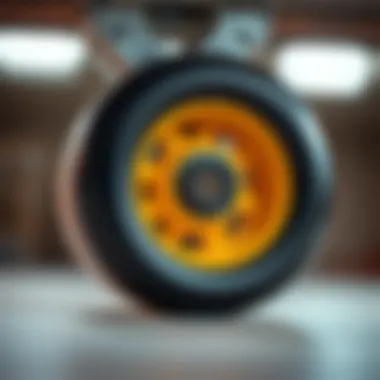
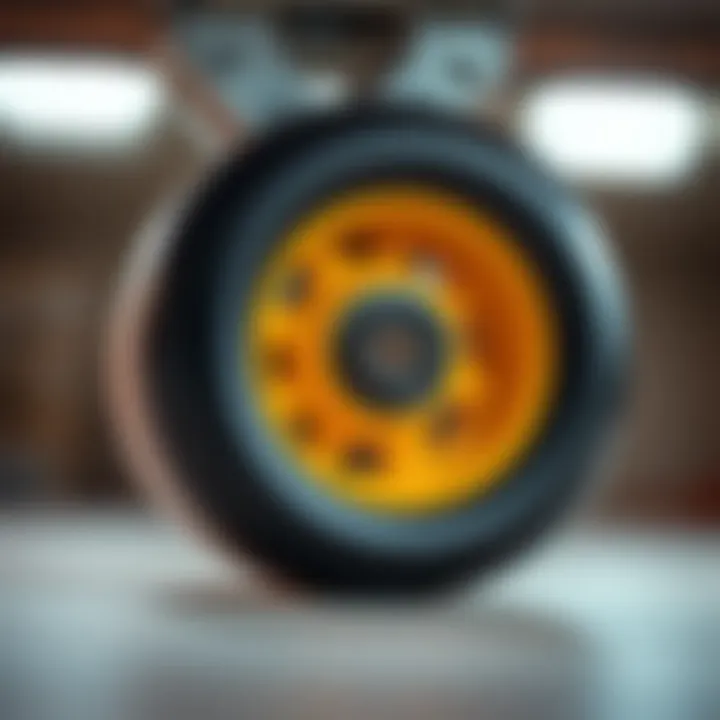
Intro
When it comes to roller skating, many factors play a role in enhancing your experience, but perhaps none are as vital as the wheels you choose. Among the various options available, the 103A roller skate wheels stand out due to their hardness rating and performance characteristics. Understanding these wheels can significantly impact your skating, whether you're attempting tight spins at the rink or navigating rough terrain outdoors.
This guide takes a closer look at 103A wheels—from their specifications and materials to their impact on different skating styles. It’s crucial to navigate this landscape with knowledge, especially for both novices and seasoned skaters alike. In the sections that follow, we will unpack key concepts to help you choose the right wheels for your skating needs.
Let’s delve into the essentials of these wheels—where they shine, how they are constructed, and why they might just be the right fit for your skating journey.
Prelude to Roller Skate Wheels
When you step onto the smooth surface of a skating rink or glide down a sunlit path, the wheels beneath your feet play a pivotal role. Understanding roller skate wheels is essential not just for performance but also for enjoyment. The comfort and safety of your skating experience often hinge on these seemingly simple components. Within this analysis, we will embark on a journey to demystify the world of roller skate wheels, shedding light on what makes them tick, or rather, roll.
Understanding Wheel Basics
Every wheel on a roller skate serves a specific purpose, participating in a finely tuned act of engineering. Roller skate wheels are generally made from urethane, a material favored for its elasticity and durability. This material allows for a variety of hardness levels, significantly affecting grip and speed. While a novice might think all wheels are created equal, the differences can be as stark as night and day.
For example, consider the typical soft wheels used for indoor skating—they provide excellent grip, making them great for sharp turns. In contrast, harder wheels are preferred for outdoor skating due to their ability to roll over rough surfaces with ease. Additionally, wheels come in assorted sizes, generally ranging from 55mm to 70mm, influencing how a skater maneuvers and controls their speed.
Knowing these basics is like having a map before setting off on a road trip. It sets the stage for informed decisions later on, especially when discussing the specific hardness of wheels, which leads us to our next section.
The Importance of Wheel Selection
Wheel selection is not just about color or aesthetics; it can fundamentally change your skating performance. The feel on the rink or path is dictated by the style of wheels you choose. Soft wheels might seem appealing for their comfort, but they wear out quickly on rough terrain. Conversely, hard wheels can be brutal on your feet during long sessions on smooth surfaces, as they lack the shock absorption that softer wheels provide.
When skaters neglect to consider their specific needs, they risk a compromised experience. Imagine gliding with wheels that are misconfigured to your style—it's like wearing shoes two sizes too small. Painful and often detrimental to skill improvement!
Take a moment to analyze your skating style. Are you more inclined toward speed skating, artistic expression, or simply rolling around for leisure? Each of these activities demands a different wheel setup. An understanding of the wheels is paramount for maximizing both performance and enjoyment.
In summary, roller skate wheels might seem like a minor detail in the grand scheme of your skating journey, but they are indeed the unsung heroes that facilitate movement, balance, and style. As we dive deeper into the world of 103A wheels, we'll explore the specifics of their hardness, material composition, and performances—essential knowledge for anyone serious about their skating.
Defining 103A Hardness
When it comes to roller skate wheels, the hardness rating is a vital aspect that can significantly affect performance and comfort. The number 103A is not just a random figure; it provides essential insight into the wheel's properties. Understanding this rating can assist skaters in making informed choices that align with their skating styles and environments.
What Does 103A Indicate?
In the realm of wheel hardness, the "A" scale is a commonly used measurement to denote how stiff or soft a wheel is. The number preceding the letter represents a specific hardness that can be translated into physical characteristics. A rating of 103A suggests a relatively hard wheel, suitable for a variety of surfaces and conditions.
Skaters seeking speed and performance typically lean toward harder wheels, as they offer less rolling resistance and greater speed potential. That said, the trade-off often comes in the form of reduced grip and shock absorption.
A harder wheel like the 103A is generally favored for efficient skating on smooth surfaces. It's perfect for those who glide on polished floors or specialized rinks, equating to quicker acceleration and a smoother ride. However, it might not be the best choice for rough terrain, where softer wheels could deliver better shock absorption and grip.
Factors Affecting Wheel Hardness
Several factors contribute to the overall hardness and suitability of the wheel for various skating applications.
- Material Composition: Different materials, such as urethane or rubber, lend varying degrees of hardness. Urethane wheels, for example, are often chosen for their durability and performance characteristics, which are critical for a hardness rating like 103A.
- Temperature Influence: Wheel hardness can also change with temperatures—sometimes, extreme heat can soften the wheel slightly, while cold may harden it. Skaters should be aware of this, particularly when skating outdoors in variable climates.
- Manufacturing Processes: The methods used in the mold and compounding process during production can lead to slight deviations in hardness. Quality control plays a crucial role in ensuring that the wheels meet the specified hardness rating.
Skaters have to weigh these elements carefully. For instance, while a 103A wheel works wonders on smooth surfaces, it may not possess sufficient grip on uneven ground or during sharp turns. Thus, understanding the broader context of hardness ratings can be a game changer for both performance and safety.
Material Composition of Roller Skate Wheels
Understanding the material composition of roller skate wheels is essential, as it directly influences their performance, durability, and overall skating experience. Different materials offer various benefits, affecting aspects such as grip, shock absorption, and wheel life. Furthermore, these materials play a crucial role in how well the wheels perform across different surfaces and conditions, thereby making informed choices a roughtly crucial aspect for skaters of all styles and experience levels.
Types of Materials Used
In general terms, roller skate wheels are primarily made from two main types of materials: urethane and plastic. However, within this realm, numerous variations exist, each with distinct characteristics.
- Urethane: This is the most common material used for high-quality roller skate wheels. It offers a balance of durability, grip, and shock absorption, making it the preferred choice among serious skaters. Urethane wheels can be found in various hardness ratings, which correlates directly with their performance characteristics. In essence, a wheel made from high-grade urethane will retain its shape longer and provide superior traction on a variety of surfaces.
- Plastic: Family members of plastic wheels are generally cheaper and less durable. While suitable for recreational skating or beginners, they simply lack the performance capabilities of urethane wheels. They're often more prone to wear and tear, making their lifespan shorter compared to urethane options. This category often includes wheels for specific targeted applications, like outdoor skating, where durability against the rugged surface is crucial.
- Hybrid composites: Some manufacturers are experimenting with hybrid materials, combining urethane with other compounds for optimized performance. These wheels aim to harness the best features of both worlds, aiming to enhance durability while maintaining adequate grip.
Ultimately, the key takeaway from this categorization? Selecting the right type of material for your wheels can significantly affect both your immediate skating experience and your long-term enjoyment.
Durability and Performance Correlation
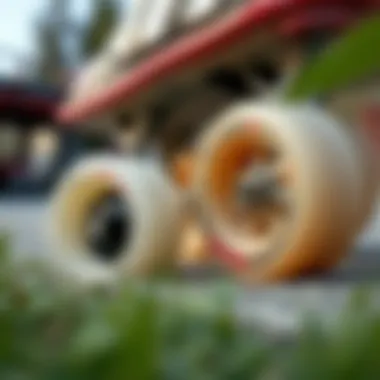
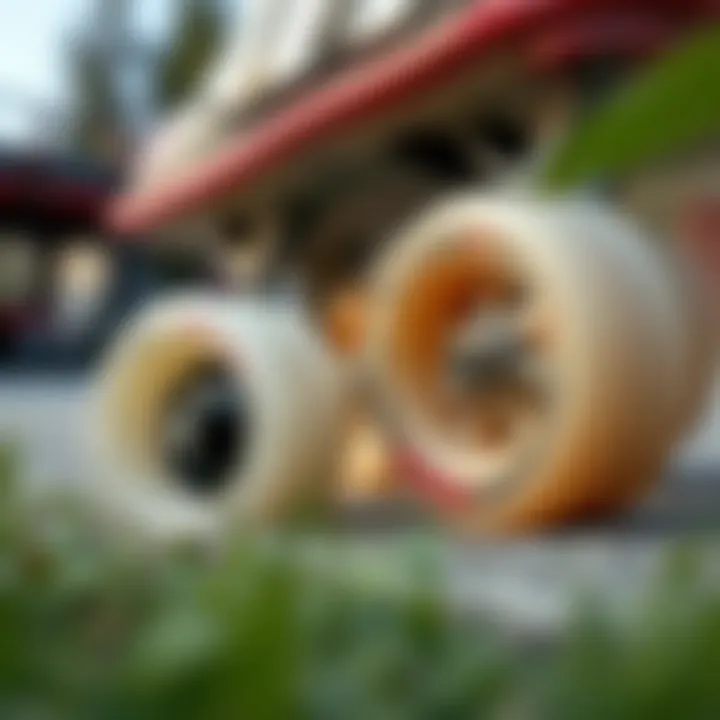
The relationship between durability and performance in roller skate wheels cannot be overstated. A wheel may excel in terms of speed and grip, but if it wears down quickly, the benefits become moot.
Several aspects inform the interplay between these two characteristics:
- Material Quality: As discussed earlier, urethane leads in the durability game. High-quality urethane wheels resist flattening and maintain their grip longer. In contrast, cheaper materials might not provide the same level of endurance.
- Wheel Hardness: The 103A hardness level indicates a firm wheel that generally holds up well under intense use. While hardness can enhance speed, it might compromise grip depending on factors like skating surface and style. This necessitates finding a balance between hardness and a wheel's ability to conform slightly to uneven surfaces without degrading.
- Environmental Factors: Skate wheels take on significant abuse from their environment—from rough asphalt to more forgiving indoor rinks. Even the elements play their part; humidity and temperature can affect how materials behave over time. Urethane typically holds up better under varying conditions compared to other materials.
"Choosing the right wheel not only affects your speed but also your safety; think of it as laying down the foundation for the entire skating edifice."
To sum it up, the durability and performance of roller skate wheels are deeply intertwined. Skaters of any level need to consider what materials align best with their personal skating style, as this choice can lead to optimization in both the short and long run.
For further reading on the implications of material choices in skating, consider visiting Wikipedia and Britannica. You might also find discussions on the topic in forums such as Reddit useful.
Performance Characteristics of 103A Wheels
When it comes to roller skate wheels, the performance characteristics are crucial for skaters seeking both speed and reliability. Specifically, 103A wheels offer a unique blend of features that cater to diverse skating environments, whether it be a smooth indoor rink or a rough outdoor path. Understanding the performance attributes of these wheels can significantly enhance a skater's experience, ensuring they pick the right tool for their specific needs.
Speed and Grip Factors
One of the standout features of 103A wheels is their superior speed capability, attributed largely to their hardness. The 103A hardness rating signifies a balance where the wheels are hard enough to roll quickly on smooth surfaces while still offering some grip. This combination is ideal for skaters who wish to zip around the rink without sacrificing stability.
- Quick Acceleration: Skaters often find that the responsiveness of harder wheels allows for faster take-offs, which is particularly beneficial during races or agility drills.
- Traction: Despite being hard, 103A wheels provide commendable traction, allowing skaters to maneuver with ease. This extended grip can be pivotal during quick turns or when needing to stop abruptly.
- Environmental Considerations: When choosing to skate outdoors, the wheel's ability to maintain speed while gripping varies based on the terrain. Smoother paths will showcase the wheel's true speed, while rougher surfaces might require skaters to factor in minor compromises in performance.
"Choosing the right wheel hardness, like 103A, can mean the difference between a smooth glide or a trip to the floor!"
Shock Absorption and Comfort
While speed is often at the forefront of a skater's mind, comfort and shock absorption are equally important, especially during longer skating sessions. Understanding how 103A wheels perform in this area allows skaters to make informed choices.
- Impact Resistance: The firmness of 103A wheels offers a solid base that minimizes excessive flex. This characteristic protects the skater’s feet and joints from the jarring effects of uneven surfaces, which can lead to fatigue or pain over time.
- Vibration Dampening: The material composition behind these wheels aids in absorbing vibrations, ensuring a smoother skate. When on more textured surfaces, it's essential that skaters experience less shock to maintain focus on their technique instead of discomfort.
- Footwear Compatibility: Depending on the type of skates used in conjunction with 103A wheels, the overall comfort can fluctuate. It's recommended for skaters to pair these wheels with adequate insoles or cushioned boots to enhance overall comfort, particularly for longer skating outings.
In summary, the performance characteristics of 103A wheels highlight their strengths in providing speed and grip, while also ensuring comfort and shock absorption. For anyone serious about their skating, understanding these dynamics not only contributes to better performance but also promotes a healthier skating experience.
Suitability for Different Skating Styles
When it comes to roller skating, selecting the right wheels is akin to choosing the perfect pair of shoes. The hardness, especially at 103A, offers varied advantages based on the skating style, making it vital for skaters to understand their needs. Different styles prioritize diverse aspects such as speed, stability, and maneuvers, therefore knowing how the 103A wheels fit into this picture can transform one's experience on wheels.
Recreational Skating
For many, skating is about leisure and enjoyment. When tapping into the recreational scene, 103A wheels provide a good balance between speed and control. The level of hardness gives enough grip to maintain stability while making those gentle turns. Riders looking to glide in a park or along a smooth sidewalk will find these wheels satisfying. The key benefit? Their ability to assist new skaters in building confidence without sacrificing performance.
Here are some factors that make 103A wheels suitable for recreational skating:
- Affordability: They are often priced reasonably, making them accessible to more skaters.
- Versatility: These wheels perform well on various surfaces, be it indoor rinks or smooth outdoor paths.
- Durability: They withstand the wear and tear associated with casual skating sessions.
Artistic Skating Considerations
Artistic skating demands precision, control, and flair, and the 103A hardness can complement these requirements. Skaters focused on choreography and intricate movements benefit from a balance of speed and grip offered by these wheels. The solidness ensures smooth transitions and assists in executing artistic elements without wobbling out of control.
Some important points to consider:
- Grip for Spins: The hardness aids in maintaining grip during spins, which is crucial for many artistic routines.
- Control for Jumps: 103A wheels offer the rigid support needed during jumps and landings, making the differences less noticeable.
- Aesthetic Variety: They come in various colors and designs that match the stylish outfits often worn by artistic skaters.
Speed Skating Applications
For the speed demons, every millisecond counts. Here, 103A wheels shine by providing the firmness essential for generating momentum without unnecessary drag. Ramping up the speed is possible while keeping the balance, which is a must during those high-speed dashes. Additionally, the design of these wheels ensures they respond well to the force applied, allowing for quick cuts and bursts of acceleration.
Key advantages in speed skating include:
- Smooth Roll: The advanced urethane used typically allows for a smooth roll over competitive tracks.
- Stability at High Speeds: The hardness provides excellent transverse stability, reducing the chance of wipeouts.
- Lightweight: They tend to be lighter than many other options, making them a popular choice for racers.
In summary, choosing the right wheels based on your skating style can significantly impact your performance and enjoyment. 103A wheels cater well to recreational, artistic, and speed-focused skates, ensuring there is something for every roller enthusiast out there.
Understanding these nuances in wheel performance connects skaters to their passion, allowing them to confidently express themselves regardless of their skating style.
Comparing 103A to Other Hardness Ratings
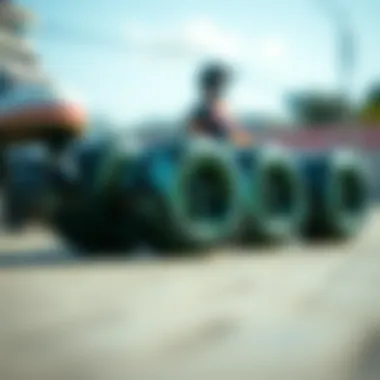
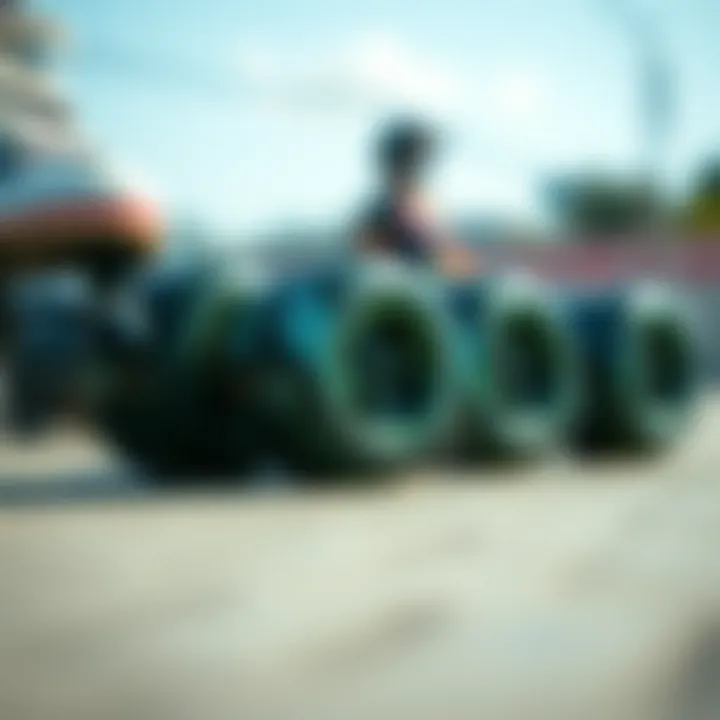
When it comes to roller skate wheels, the hardness rating can be a game-changer. This section dives into how 103A stacks up against various hardness ratings, moving beyond mere numbers to understand the implications for performance and feel. Knowing how 103A measures against others helps skaters make wiser selections tailored to their personal style and needs.
Pros and Cons of Hardness Variations
Identifying the strengths and weaknesses of different hardness levels equips you with the knowledge essential for chossing the best wheels for your skating experiences. Here’s a brief look at some pros and cons:
Pros of Hardness Variations:
- Enhanced Grip: Softer wheels (like 78A to 88A) often provide better traction, making them suitable for artistic skating or uneven surfaces.
- Increased Shock Absorption: Softer wheels absorb shocks effectively, which is beneficial for recreational skaters who wish to feel comfortable on their feet.
- Versatility: Hardness levels greater than 103A (like 104A or 105A) enable skaters to gain speed efficiently, making these ideal for those focusing on racing or high-speed circles.
Cons of Hardness Variations:
- Less Control: Softer wheels can lead to a less stable feeling, making it harder to maneuver sharply.
- Reduced Durability: While softer materials wear down faster, harder wheels might resist deformation better but can also become slippery on certain surfaces.
- Specialized Needs: Each hardness level suits specific applications. For instance, while 103A might be perfect for speed skating, a softer wheel would be more ideal for casual, leisure activities.
Appropriate Usage Scenarios
Every skating discipline calls for a unique wheel hardness to optimize the experience. Knowing when to use 103A versus softer or harder wheels depends on a variety of factors.
- Speed Skating: For those hell-bent on going fast, 103A wheels serve as an excellent choice. These wheels allow for efficient energy transfer and responsiveness.
- Artistic Skating: While 103A can work, those masters of grace often prefer softer options for better grip during spins and tricks.
- Recreational Skating: Casual skaters looking for a balance can rely on 103A wheels, especially on smoother surfaces like rinks or well-maintained outdoor paths.
"The right wheel can make the difference between gliding and struggling."
Understanding these scenarios allows you to choose wisely for your specific approach to skating. With so many choices, honed comprehension of the wheel ratings might just be the edge a skater needs to elevate their game.
For more information on hardness ratings and specific performance scenarios, visit Wikipedia or Britannica.
In the end, striking the right balance with wheel hardness not only enhances your skating performance but also makes the entire experience more enjoyable.
Maintenance and Longevity of Roller Skate Wheels
Maintaining and extending the life of roller skate wheels is essential for every skater, whether you’re gliding around your local rink or zooming through an open park. Proper care not only ensures the wheels function at their best but also enhances the overall skating experience. When roller skate wheels age or wear down, performance can diminish, impacting speed, control, and comfort—three crucial factors for any skater.
Cleaning and Care Techniques
Keeping wheels clean is a vital part of maintenance that often gets overlooked. The first step in maintaining 103A wheels is to wipe them down after each skating session. Dirt and debris can accumulate on the surface, making the wheels less effective. A simple cloth dampened with water or a mild cleaning solution can do wonders.
- Remove Wheels for Thorough Clean: Taking the wheels off your skates makes it easier to clean both the wheels and the skate itself. This gives you a chance to inspect the bearings and inner rims for any gunk.
- Bearings Matter: Pay special attention to the bearings. They are the heart of the wheel's performance. Clean them using a specialized bearing cleaner or, if you’re in a pinch, some rubbing alcohol. After cleaning, a light application of skateboard lubrication keeps them running smoothly.
- Dry Properly: After cleaning, ensure every part is dried completely. Moisture can lead to rusting, which ultimately jeopardizes durability.
With a regular cleaning schedule, you can significantly enhance your 103A wheels' lifespan and maintain optimal performance. Regular care can prevent issues that might require premature replacement.
Signs of Wear and When to Replace
Every skater must be alert to the signs that indicate when it's time to replace their wheels. Ignoring these signs can lead to compromised safety and performance. Here are some key indicators that suggest your 103A wheels are nearing the end of their lifespan:
- Visible Wear and Tear: Look for flat spots, chips, or any irregularities on the wheel surface. A wheel that's lost its roundness isn’t going to perform well.
- Loss of Grip: If you find yourself slipping more often, it’s a red flag. The hardness of 103A wheels means they are designed for specific conditions; once they lose grip, it’s time to consider replacements.
- Noise and Vibration: Strange sounds, grinding noises, or increased vibration when skating can indicate worn bearings or wheel issues. If you’re noticing these anomalies, take a closer look.
- Inconsistent Performance: Noticeable changes in how your skates feel or handle can also hint at the wheels needing replacement.
Tip: Keep a close eye on your wheels; checking them regularly can prevent the need for emergency upgrades or costly repairs down the line.
Replacing wheels at the right time can save money and enhance the enjoyment of skating. A well-maintained setup ultimately leads to a smoother, more enjoyable experience on the rink or on the road.
Purchasing Considerations for 103A Wheels
When it comes to selecting the right roller skate wheels, especially the 103A variety, there’s a whole host of factors worth pondering. These decisions can significantly impact your skating experience, suggesting that it pays dividends to do thorough research and not rush into the purchase. From material to brand reputation, understanding these aspects can mean the difference between a smooth glide down the rink and an uneven, bumpy ride.
Identifying Quality Manufacturers
Not all manufacturers are created equal, and this is particularly true in the world of roller skate wheels. When seeking 103A wheels, it’s crucial to pinpoint brands that have shown consistency in quality and performance. The reputation of the manufacturer can provide invaluable insight into durability and reliability.
Some indicators of quality include:
- Material sourcing: Brands that focus on high-grade urethane or other top materials are often more reliable.
- User feedback: Check for community reviews and experiences on platforms like Reddit or skating forums. See what other skaters are buzzing about.
- Warranty and customer service: Reliable manufacturers often have solid warranties and responsive customer service, ensuring that if anything goes awry, you're covered.
In this connection, companies like Riedell and Atom have built a reputation over the years. Their commitment to quality speaks volumes and is often echoed through user testimonials. Doing due diligence in this regard can save you both time and money in the long run.
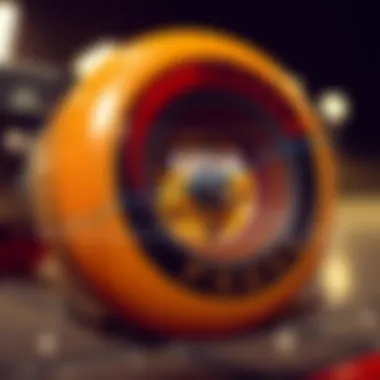
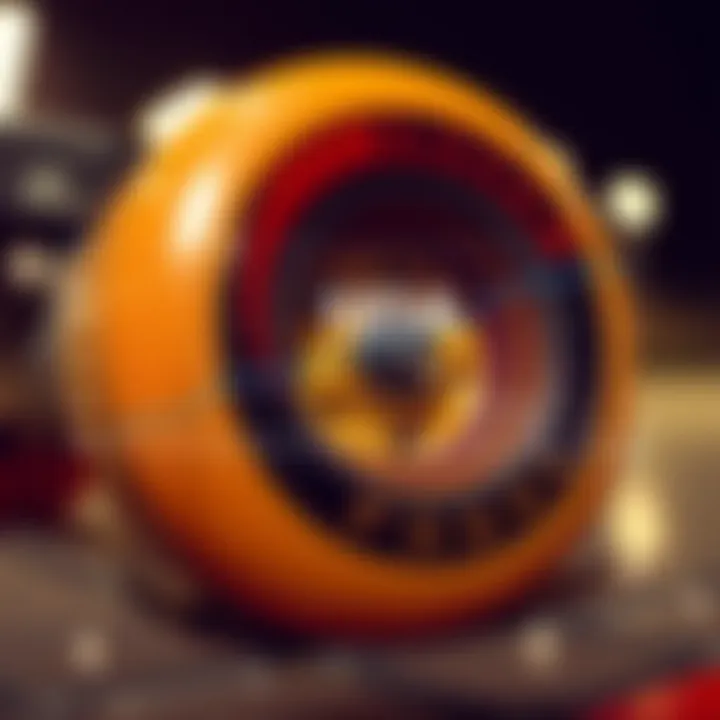
Online vs. In-Store Shopping
The age-old debate between shopping online versus hitting the local skate shop takes on new relevance when it comes to 103A wheels. Each method has its perks and pitfalls, and understanding them can help skaters make an informed decision that best suits their needs.
1. Online Shopping
- Wider selection: Online vendors typically offer a broader range of choices, often including the latest models that might not be available in local shops.
- Price comparison tools: Websites allow you to compare prices across multiple platforms, helping you find the best deal.
- Reviews at your fingertips: Most online stores feature user reviews right on the product page. This instant feedback can help you gauge the quality before committing.
However, the downside is that you can’t physically inspect the wheels until they arrive, and returning items can sometimes be a hassle.
2. In-Store Shopping
- Hands-on experience: Visiting a physical store allows you to touch and examine the wheels, giving you a better understanding of their quality and feel.
- Expert advice: Staff in specialized skate shops can offer personalized recommendations based on your specific needs and skating style.
- Instant purchase: You can walk out with the wheels in hand, which is a significant advantage if you're in a hurry.
On the other hand, your choice might be limited based on the store’s inventory.
In making a choice between online and in-store shopping for 103A roller skate wheels, weigh your priorities. If you value expert advice and immediate acquisition, local shops may be better suited for you. Conversely, if variety and price are higher on your list, online shopping could be your go-to.
To wrap it all up, purchasing 103A wheels is more than just a transaction; it’s an investment in your skating journey. Consider all factors, do your homework, and let your skating flourish accordingly.
"In skating, as in life, every choice leads you down a different path. Choose wisely to glide gracefully."
For further information on roller skating gear, potential buyers can visit resources such as Wikipedia, or specialised skate shops for hands-on guidance.
User Preferences and Feedback
Understanding user preferences and feedback can be invaluable in the realm of roller skating, particularly when examining 103A wheels. The feedback from skaters—be they beginners, experts, or instructors—provides insights that can steer manufacturers and consumers alike towards better choices, greater satisfaction, and enhanced performance.
In this section, we'll delve into what actual users are saying about 103A wheels and how this feedback shapes the community's understanding of roller skate performance. This consideration extends beyond personal comfort, diving into factors that affect overall skating experience.
What Skaters Are Saying
The sentiments regarding 103A wheels seem to oscillate largely between appreciation for speed and criticism regarding shock absorption. Many skaters, especially those who favor speed, commonly praise the wheels for their remarkable grip and its ability to maintain high velocity while maneuvering. Comments frequently highlight:
- Speed: Enthusiasts note that these wheels excel on smooth surfaces, allowing for an exhilarating experience when zooming around the rink.
- Durability: Numerous users are impressed with the longevity of the wheels, stating that after several months of regular use, there are hardly any signs of deterioration.
- Responsive Handling: Skaters have pointed out that 103A wheels provide a responsive feel that can significantly enhance performance during sharp turns or sudden stops.
However, this feedback isn't all rosy. Numerous reviews mention a notable trade-off with comfort. Some skaters report that while the ride is fast, the hardness of 103A wheels can lead to discomfort on rough terrain or less-than-ideal surfaces. This leads some to suggest:
"For a skating session in the park or uneven sidewalks, you might want something with a little more give, even if it means sacrificing speed."
Community Ratings and Reviews
Looking at community ratings, they often reflect a mixed bag of opinions. On various skating forums and product review sites, sires like Reddit and specialized roller skate communities provide a platform for shared experiences.
- Overall Ratings: Ratings for 103A wheels often hover around 4 out of 5 stars. Quite a few users appreciate their performance, while others emphasize that they are not a one-size-fits-all solution.
- Category-Specific Feedback:
- For recreational skaters, comments suggest that while fun, these wheels may not suit everyone’s comfort needs.
- For artistic skaters, feedback indicates that they might lack the required softness for some moves, ultimately impacting their artistic flair.
- The speed skating community, though, seems to rally around the 103A wheel's speed and grip.
For further insights and discussions on roller skate wheels, consider visiting Reddit or Facebook Groups dedicated to skating enthusiasts.
Users looking to delve deeper can also check out resources like Wikipedia or Britannica.
Closure: Summary and Recommendations
In the intricate world of roller skating, understanding the nuances of wheel specifications, particularly the significance of a hardness rating such as 103A, cannot be overstated. This article has meticulously outlined important aspects regarding 103A roller skate wheels, enabling users to make informed decisions based on their particular skating needs.
The insights gathered here are not merely academic; they are practical and applicable in real-world scenarios. With the right wheels, skaters can experience enhanced performance, satisfaction, and safety during their activities. For a better grasp, consider the following elements highlighted in this article:
- Material Composition: The makeup of the wheels impacts everything from durability to responsiveness. Knowledge of materials helps in choosing wheels that suit your environment.
- Performance Characteristics: Getting the right fit for one's skating style can make all the difference. This includes understanding how the hardness of the wheel affects speed, grip, and comfort.
- User Preferences: Feedback from fellow skaters offers invaluable insights about real-life experiences with different wheels, which can guide your choices considerably.
Ultimately, whether one skates for leisure, artistic expression, or speed, the right wheels will lead to a more enjoyable experience. Being picky about wheel selection is key, and considering the unique attributes of 103A wheels can help you hit the ground rolling rather than stumbling.
Recap of Key Points
To recap, here are the essential points covered in the article about 103A roller skate wheels:
- Hardness Rating: 103A represents a high level of hardness, suitable for various skating styles.
- Material Types: Wheels are crafted from different materials, influencing performance and durability.
- Performance Trade-offs: Harder wheels like 103A can provide speed but may compromise grip and comfort under certain conditions.
- Skater Feedback: Real user experiences can significantly help in deciding which wheels to purchase based on expectations and performance.
Final Thoughts on Choosing 103A Wheels
Don’t hesitate to reach out to fellow skaters for their opinions or check platforms like Reddit for discussions. Quality wheels are an investment in your skating journey. With the information set forth here, it’s clear that well-informed choices lead to enhanced performance and satisfaction on wheels. Remember, the focus should be on what connects you best to the skating experience.



